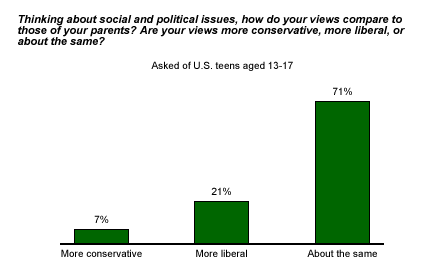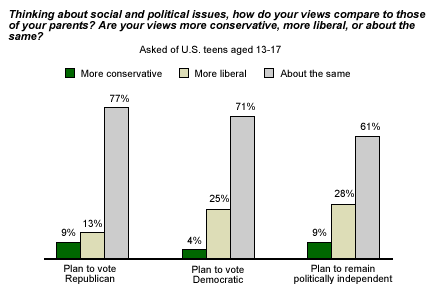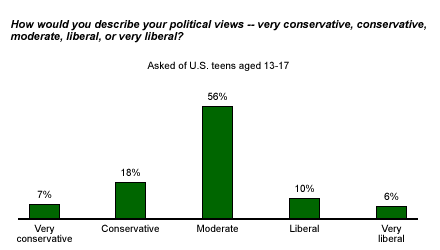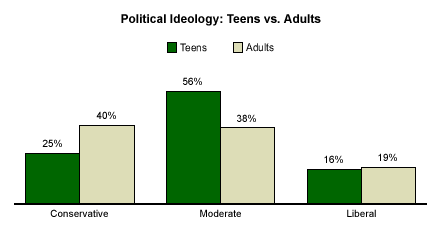Are the great generation-splitting debates that were characteristic of the 1960s and 1970s -- about everything from politics and religion to drugs and hair -- splitting today's generations? Not if the results of a new ║┌┴¤═° Youth Survey*, which asked teens to compare their social and political views with those of their parents, are any indication. While a fifth of U.S. teens (21%) say they are "more liberal" than their parents and 7% say "more conservative," 7 in 10 teens (71%) say their social and political ideology is about the same as mom and dad's.

The finding doesn't surprise Phillip Longman, a senior fellow at the New America Foundation and the author of books and articles dealing with demographics and public policy.
"…Today's young people are exceptionally bonded to their parents," he says. "At the same time, the notion that society is ever seriously torn by generational conflict is probably overblown. I, too, am a child of the 1960s and 70s, and so the harmony that exists today between parents and their children does seem a bit strange compared to my own rebellious youth. But even among baby boomers, those who wound up having children have turned out to be remarkably similar to their parents in their attitudes about 'family' values."
There are few differences among demographic groups on this question; boys and girls are equally likely to say that they share the same political and social views as their parents, as are white and nonwhite teens. One area in which differences do emerge among teens is along the lines of political party identification. Only 9% of teens who say they will align with the Republican Party when they are old enough to vote indicate that their views are more conservative than their parents (77% of future Republicans say their views are similar to their parents). But 25% of future Democrats and 28% of future independents tell ║┌┴¤═° they are more liberal than their parents.

Teen Political Ideology
According to a ║┌┴¤═° Youth Survey from early 2004**, the majority of teens, 56%, identified themselves as political moderates, while 25% said they were "very conservative" (7%) or "conservative"(18%) and 16% describe themselves as "very liberal" (6%) or "liberal" (10%).

Boys were about twice as likely to say they are politically conservative (33%) as were girls (17%). Fourteen percent of boys said they are politically liberal, as did 20% of girls, while all the rest -- 61% of teen girls and 51% of teen boys -- described their views as moderate.
A slight difference appeared by race -- 29% of white teens said their views are conservative, compared with 18% of nonwhites. Similar percentages of white teens (16%) and nonwhite (18%) teens called their views liberal. The rest -- a small majority (52%) of whites and a more substantial majority of nonwhites (62%) -- told ║┌┴¤═° they are political moderates.
Comparison of Teen and Adult Political Ideology
How do teens differ from adults in their self-identified political ideologies? The main difference is in the percentages identifying as moderates: 38% of adults describe their political views as moderate***, while a majority of teens (56%) do so. Similar proportions of adults (19%) and teens (16%) say they are political liberals, but significantly more adults than teens subscribe to the "conservative" label -- 40% vs. 25%. It is unclear whether the higher proportion of teens identifying as moderates results from a crystallizing of political views as people age or whether it could partly reflect the ways which the surveys were administered (adult interviews conducted by telephone, teen by Internet).

Bottom Line
By describing their political views as "moderate," many teens may be taking a wait-and-see attitude as they continue to develop their own political consciousness. But given that 7 in 10 currently say they're sticking close to their parents' positions on the ideological spectrum, many will possibly continue the voting tradition of at least one older family member.
*The ║┌┴¤═° Youth Survey is conducted via an Internet methodology provided by Knowledge Networks, using an online research panel that is designed to be representative of the entire U.S. population. The current questionnaire was completed by 439 respondents, aged 13 to 17, Aug. 8-19, 2004. For results based on the total sample, one can say with 95% confidence that the maximum margin of sampling error is ±5 percentage points.
**The ║┌┴¤═° Youth Survey is conducted via an Internet
methodology provided by Knowledge Networks, using an online
research panel that is designed to be representative of the entire
U.S. population. The current questionnaire was completed by 785
respondents, aged 13 to 17, between Jan. 22 and March 9, 2004. For
results based on the total sample, one can say with 95% confidence
that the maximum margin of sampling error is ±4 percentage
points.
***Results are based on telephone interviews with 37,330 national adults, aged 18 and older, conducted in 2004. For results based on the total sample of national adults, one can say with 95% confidence that the margin of sampling error is ±1 percentage point.